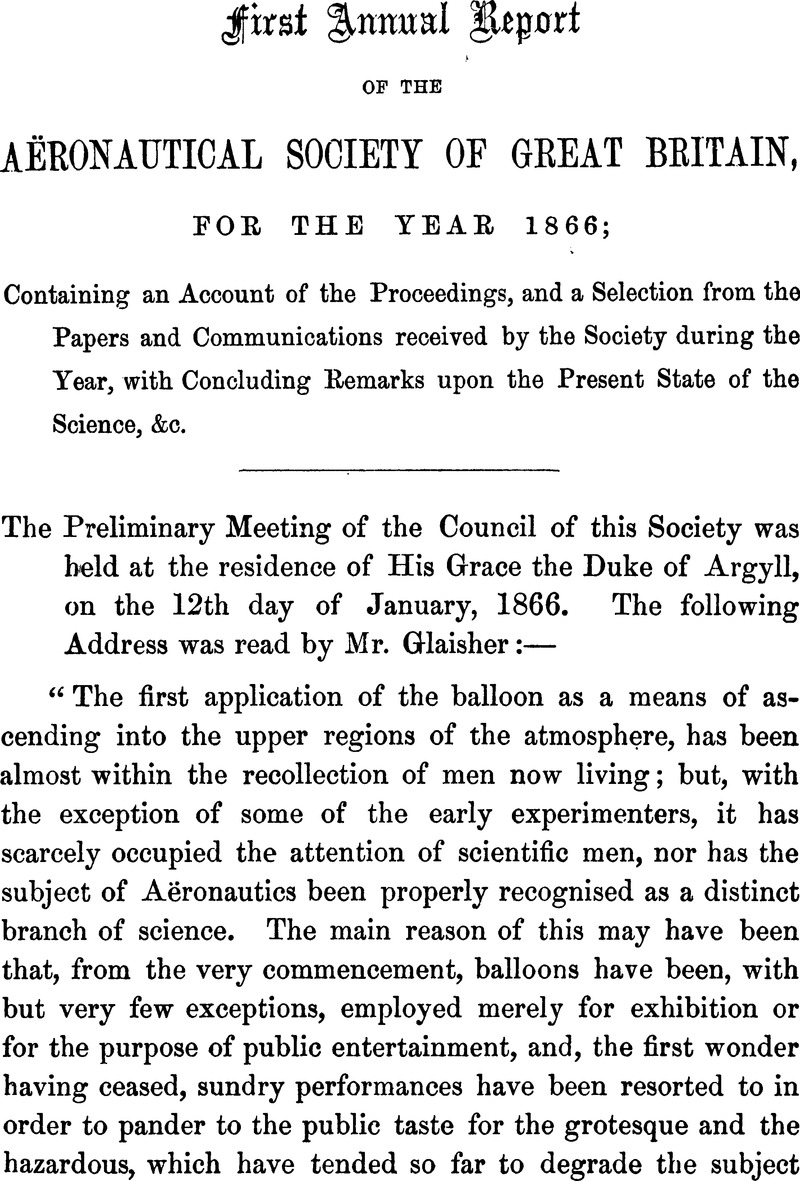No CrossRef data available.
Article contents
First Annual Report Of The Aeeronautical Society Of Great Britain, For The Year 1866
Published online by Cambridge University Press: 08 May 2017
Abstract

- Type
- Meeting Report
- Information
- Copyright
- Copyright © Royal Aeronautical Society 1867
References
page 31 note * The practical application of these suggestions appears to have been anticipated some years previously. In a small work, styled the“ History of the Charvolant, or Kite Carriage,” published by Longman and Co., appears the following remarks :—“These buoyant sails,possessing immense power, will, as we have before remarked, serve for floating observatories. * * * * Elevated in the air, a single sentinel, with a perspective, could watch and report the advance of the most powerful forces, while yet at a great distance. He could mark their line of march, the composition of their force, and their general strength, long before he could be seen by the enemy.”Again, at page 53, we have an account of ascents actually made, as follows:—“ Nor was less progress made in the experimental department, when large weights were required to be raised or transposed.While on this subject, we must not omit to observe that the first person who soared aloft in the air by this invention was a lady, who courage would not be denied this test of its strength. An arm-chair was brought on the ground, then lowering the cordage of tho kite by slackening the lower brace, the chair was firmly lashed to the main-line, and the lady took her seat. The main-brace being hautedtaut, the huge buoyant sail rose aloft with its fair borden, continuing to ascend to the height of 100 yards. On descending, she expressed herself much pleased with the easy motion of the kite, and the delightful prospect she had enjoyed. Soon after this, another experiment of a similar nature took place, when the inventor's son successfully carried out a design not less safe than bold ; that of scaling, by this powerful aërial machine, the brow of a cliff 200 feet in perpendicular height. Here, after safely landing, he again took his seat in a chair expressly prepared for the purpose, and, detaching the swivel-line, which kept it at its elevation, glided gently down the cordage to the hand of the director. The buoyant sail employed on this occasion was thirty feet in height, with a proportionate spread of canvas. The rise of the machine was most majestic, and nothing could surpass the steadiness with which it was monœuvred; the certainly with which it answered the action of the braces, and the ease with which its power was lessened or incresed.* * * Sub-sequently to this an experiment of a very bold and novel character was made upon an extensive down, where a wagon with a considerable load was drawn along, whilst this huge machine, at the sametime, carried an observer aloft in the air, realising almost the romance of flying.”
It may be remarked that the brace-lines here referred to were conveyed down the main-line and managed below; but it is evident that the same lines could be managed with equal facility by the person seated in the ear above ; and if the main-line were attached to a water-drag instead of a wheeled car, the adventurer could cross rivers, lakes, or bays, with considerable latitude for steering and selecting the point of landing, by hauling on the port or starboard brace-lines as required. And from the uniformity of the resistance offered by the water-drag, this experiment could not be attended with any greater amount of risk than a land flight by the same means.
page 47 note * The following quotation, from “Astra Castra,” by Hatton Turnor, page 28, appears to show that this idea has already been tested:— “Soon after Bacon’s time, projects were instituted to train up children from their infancy in the exercise of flying with artificial wings; which seemed to be the favourite plan of the artists and philosophers of that day. If we credit the accounts of some of these experiments, it would seem that considerable progress was made that way. The individuals who used the wings could skim over the surface of the earth with a great deal of ease and celerity. This was accomplished by the combined faculties of running and flying. It is stated that, by an alternately continued motion of the wings against the air, and the feet against the ground, they were enabled to move along with a striding motion, and with incredible speed.”—ED.
page 51 note * If a bird possess an equivalent of one square foot of wing-surface for each pound weight, then, in order to produce a similar reaction or supporting effect, or to raise this weight, the wing must strike on the air at a speed of 1,300 feet per minute, and even then the support will be only momentary during the down-stroke. Taking the common rook, for example, where the relation of surface to weight is nearly in the above proportion. In this bird, during flight, the mean arc of vibration of the wing is under one foot. Therefore, if flight is performed by means of any valvular arrangement of the surface, the wing must make nearly 2,000 vibrations per minute, in order to keep the bird sustained. Observation of the flight of the rook will show that it-never moves its wings at this rate.—ED.
page 55 note* The long brass tube here referred to was jointed on to the boiler like a movable arm, and was intended to convey steam to the engine connected with the flying mechanism; so that while the heavy boiler remained below, the engine might fly without having this weight to support, which it probably would have failed in doing. Had vulcanised india-rubber flexible steam-pipe been known at that time, the author of this paper would probably have preferred employing it in his experiments. The idea is very ingenious, and worthy the attention of experimenters on aëronautical subjects, as a continuous, uniform, and ample supply of power may be sent up from below. A wound-up spring has generally proved unsatisfactory, on account of the limited duration of the force.—ED.




